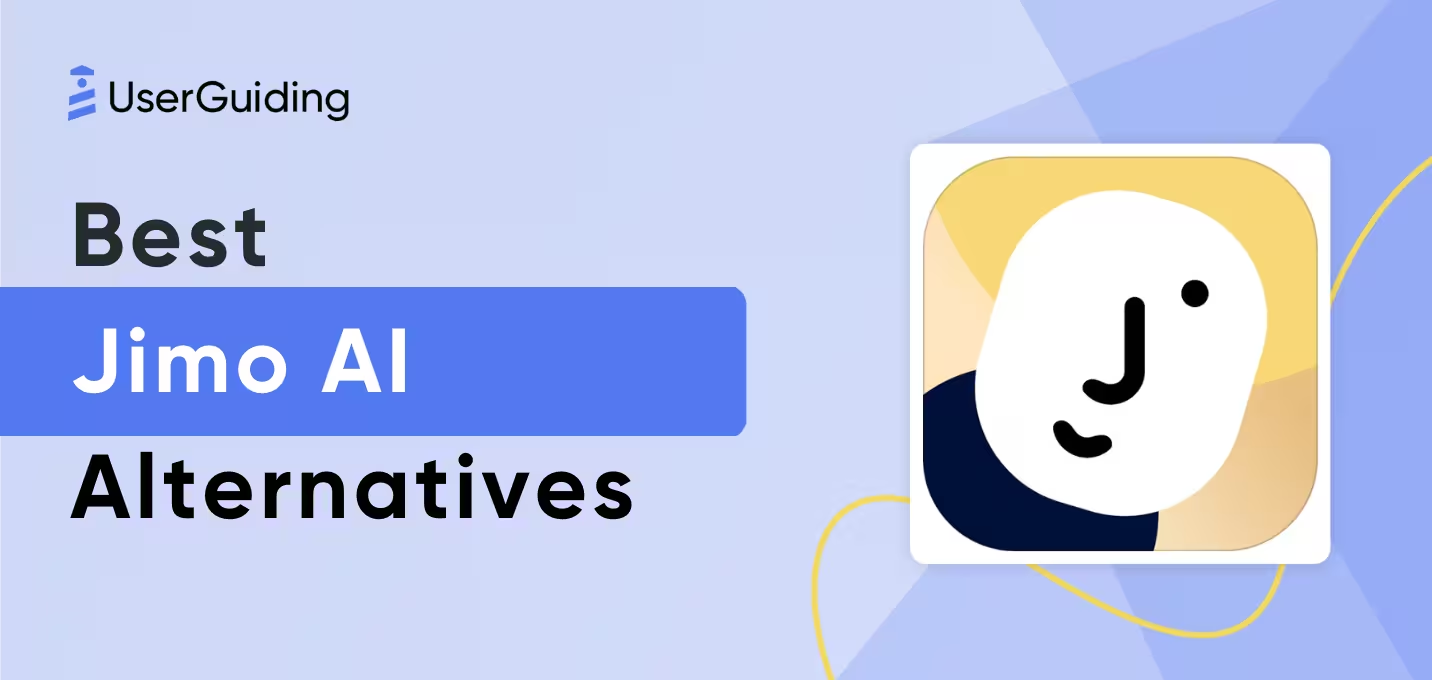

When it comes to user onboarding and product adoption, Userflow is among the top tools in social media posts, forum discussions, blog articles… So it’s safe to assume that there’s a lot of information about the tool out there.
But if you’re still curious about how you can use a tool like Userflow to grow your business, then you’re at the right place! ⭐
In this article, we’ll talk about:
- What Userflow is,
- Its top features and use cases,
- How much Userflow costs, and
- Pros and cons of using Userflow for user onboarding and product adoption.
TL;DR
- Userflow is a no-code user onboarding platform that helps you enhance user experiences by providing product tours, in-app messaging, and multi-environment support.
- Other use cases of Userflow include:
- Product adoption
- Trial conversion optimization
- User reactivation
- Userflow’s strong features are:
- Kanban-style flow builder
- In-app announcements
- AI assistant
- Segmentation
- Userflow’s weaknesses are:
- Expensive
- No standout features, many other tools offer the same essential capabilities
- More developer involvement is needed
- Limited customization
- If you need additional features like a native knowledge base and Userflow’s pricing is not justifiable for the value you’ll get, it’s time to look for an alternative tool, such as UserGuiding.
- UserGuiding offers built-in knowledge bases and product analytics, which enhance the user experience and provide more comprehensive insights into user behavior and engagement.
- It doesn’t rely on developers, so your non-technical team members can launch personalized in-app experiences quickly.
What is Userflow?
Userflow is a no-code user onboarding platform to build product tours, onboarding checklists, resource centers, and surveys for your product and users.
In 2024, Userflow merged with Beamer, a customer communication tool. This merger aims to create an “all-in-one product growth toolkit”.

You can also segment users, announce new features, and get multi-environment support from Userflow’s team.
What is Userflow used for?
Userflow, especially after merging with Beamer, has become an intuitive and versatile tool both for your development team and customer base. Many SaaS companies use Userflow for:
- User onboarding
- Product adoption
- User engagement
- New feature announcements and product updates
- In-app communication
What are Userflow’s top use cases and features?
We can divide Userflow’s top use cases into four categories: user onboarding, product adoption, trial conversion optimization, and user reactivation.
In this section, we’ll explore these key use cases and break down the specific features that support each one, so you can unlock the full potential of your product👇
Userflow for user onboarding
Userflow (as the name suggests) is first and foremost an onboarding platform that helps you create user flows and get them to quickly understand your product and see value early on.
Key features for this use case include:
- Kanban-style flow builder: With Userflow, you can build smart user onboarding flows with a few clicks. This no-code kanban builder is fast, customizable, and does not require any manual tagging.

The builder uses an algorithm that identifies the elements in your app using simple text. Moreover, it comes with the option to take screenshots of your onboarding flow. In other words, it is great for visualizing your work and helping you increase your efficiency.
- Onboarding checklists: It’s important to guide users within the context of your app and encourage them to take action as quickly as possible. Userflow’s onboarding checklists do that: keep users on task with guided lists.

You can add as many tasks as you want and customize them with buttons and launch them based on users’ actions (which may require a bit of JavaScript coding). These checklists can also be dynamically updated as users go, so they always know what’s next.
Userflow for product adoption
User onboarding and product adoption usually go hand in hand. How will users take advantage of your app to accomplish their goals? What will you offer to turn visitors into long-term paying users?
In addition to onboarding features, Userflow provides features to drive engagement by encouraging users to explore and use new or underutilized features.
Here are some features that stand out in this use case👇
- In-app announcements: Userflow’s in-app announcements are designed to notify users of new features or updates through banners, pop-ups, or modals. These announcements are integrated within your resource center.

This feature lets you track which users have seen each announcement and display a notification badge on the resource center launcher.

You can also highlight important announcements with popouts, Toast, or Modal to increase visibility. Above is an example of what popouts look like.
- Resource centers: Resource centers are one of the most popular features of Userflow, and for a good reason. With the motto of “help users help themselves,” Userflow’s resource centers aim to provide an always-on, contextual, and personalized help for users.

Users can search your existing knowledge base within your app, trigger product tours on their own whenever they need a refresher or want to discover a new feature, and get contextual help from the AI assistant.
To build your resource center, you can use example blocks and customize them. These are checklists, lists of flows, knowledge base, contact, action, message, sub-page, announcements, and AI assistant blocks.
Userflow trial conversion optimization
Beyond onboarding and product adoption, many companies use Userflow for trial conversion optimization. This is the process of moving free trial users to become paying customers.
Here’s what Userflow offers for this use case:
- Behavior-based targeting: A first-time user’s needs will naturally be different from your power users who know your app like the back of their hand. That’s why it is important to customize your flows, especially for high-intent trial users.

The best way to target these users is through segmentation. Although Userflow is not the only tool offering this feature, it is still necessary to segment and then target users to create the best experience possible.
You can create and edit your own segments based on company attributes and product event filters. It is also possible to manually segment users based on CSV upload, UI selection, and integrations.

Above is an example of building a segment in Userflow☝️This particular segment is created based on product events in your app, such as users visiting the “Billing Page”. This segment updates in real-time, which ensures accurate targeting.
⚠️ However, keep in mind that Userflow has yet to introduce the ability to use event-based segments as filters on analytics, which might limit your experience in analyzing data.
- In-app surveys: Collecting user feedback and measuring customer satisfaction are necessary to guide users to their “aha” moments where they can see the value of your product and subscribe to a paid plan. In Userflow, you can achieve this by creating in-app surveys.

In addition to question flows (built within the Flow builder), you can access different question types: NPS, multi-line text, multiple choice, scale, single-line text, and star rating.
Also, users are guided through these surveys dynamically, meaning that the flow of the survey changes based on users’ responses, so it’s more relevant to their experience.
⚠️ Again, Userflow is not the best when it comes to analytics. Users report that there are not enough features to analyze survey responses and the existing ones are quite “basic”.
Userflow for user reactivation
If one side of the coin is trial conversion, the other side is definitely user reactivation. The goal is to win back inactive users by re-engaging them with personalized experiences, and it’s one of Userflow’s main use cases.
Key features of this use case include:
- AI-powered support: When your flows cannot reach users, Userflow’s AI assistant steps in. This allows you to provide instant and personalized support based on users’ queries, powered by your knowledge base, website, and of course, OpenAI’s GPT-4.

You can integrate your help center in Salesforce, Zendesk, and Intercom with this assistant. Chatbot-style support is especially great when users return but don’t take action within your app. They can ask questions or get assistance without needing to contact support.
⚠️ Similar to other use cases of AI, the assistant may lack deep understanding of complex user contexts unless flows are tightly scoped and well-segmented. AI can suggest flows, but keep in mind that intricate behavioral targeting may still require manual setup and logic.
How much does Userflow cost?
Userflow offers three different pricing plans: Startup, Pro, and Enterprise. All of these plans are priced based on the number of monthly active users (MAUs) you have. The primary plans include:
- Startup: $240/mo, paid annually. Up to 3,000 MAUs. This plan is ideal for startups and small businesses.
- Pro: $680/mo, paid annually. Up to 10,000 MAUs. This plan is ideal for fast-scaling startups and mid-market businesses.
- Enterprise: Custom pricing. This plan is ideal for large enterprises with specific requirements (security, features, etc.).
While Enterprise pricing is not public, you can get a good sense of whether other pricing plans are within your budget by checking user reviews👇

For example, this user points out that Userflow can get expensive really fast for small businesses. This is because even though the AI assistant is included with the base product, there’s a message limit in each pricing plan. If you exceed that limit, you’ll have to pay extra.

Another concern for small businesses is that pricing can be fluctuating. This is especially true for companies who see a seasonal surge in traffic, which would affect their MAUs and in turn, the cost of Userflow.
This can cause issues with your annual budget as well and it is important to consider that before subscribing for a paid plan. 🔍
What are the pros of Userflow?
✅ Ease of use: Userflow offers easy-to-use, no-code builder for onboarding flows. A user on G2 comments on how easy it is to implement new things to their product and the flexibility it provides.
✅ Intuitive interface: Userflow’s UI is intuitive with a clean, modern design. A G2 reviewer notes it as “the most important feature” because the interface makes editing so much easier. The user adds that the visual layout and properties panel provide a good overview for making changes or creating new elements with the app.
✅ Customization: Userflow offers highly customizable flows with branching logic. One of its users appreciates that you can easily use the essential onboarding elements but also “dive into more advanced stuff and do highly contextual experiences later on in the user journey”.
✅ Multi-language support: The platform supports various languages for your onboarding needs. A user mentions that the multi-language support was the “key” in choosing Userflow.
What are the cons of Userflow?
❌ Pricing: The cost can add up quickly, especially for early-stage teams with limited budgets. A user on Reddit finds Userflow (and other similar tools) very expensive for one use case. If you are only going to use a few core features, then Userflow might not be the best fit for you.
❌ No standout features: Userflow is definitely a versatile tool for user onboarding and product adoption. It offers all the essentials from interactive product tours to in-app surveys. However, that’s about the extent of it. It has no unique features that other product adoption tools do not offer. When this is added to the higher price point, it’s normal to ask, “Do I need to pay extra for features I can get somewhere else and for cheaper?”
❌ No mobile support: Userflow is focused on web apps, so it doesn’t support onboarding for native mobile applications.
❌ Dependence on JavaScript: Userflow requires the correct setup of custom events and user data via code, which might need developer involvement. Even if you are comfortable using JavaScript regularly for the sake of making Userflow efficient for you, it doesn’t necessarily mean that it will work well. In fact, a user on G2 shares that updating elements with JavaScript makes the click editor difficult to use. Win-win or lose-lose?
❌ User attributes: Dynamic targeting and personalization rely on consistent user attributes being passed to Userflow, which makes Userflow not ideal for apps without stable user data or rapidly changing products.
❌ Design limits: While the builder is user-friendly, advanced customization of UI elements can feel constrained compared to fully custom-coded solutions.
A better alternative to Userflow: UserGuiding
Userflow is great for teams just getting started with user onboarding and product adoption.
But is it great for advanced analytics and in-app engagement? No. It lacks standalone features and sits on the higher end of the price range.
An alternative tool can give you more options at a reasonable price, such as UserGuiding.
UserGuiding is a no-code digital adoption platform that helps you improve in-app experiences so that users can quickly see your product’s value. It's designed to boost product adoption, improve user activation, and reduce churn by empowering teams to build engaging experiences fast.
What sets UserGuiding apart from Userflow is that while the former is mainly a user onboarding tool, the latter is a well-rounded product adoption platform with standalone features and a better price point.
Like Userflow, UserGuiding is also a no-code solution and provides a Chrome extension for building flows, supports onboarding checklists, and offers various in-app survey types.

Having some similarities to Userflow’s main capabilities, UserGuiding’s key features include:
- Product tours
- In-app and NPS surveys
- Onboarding checklists
- Hotspots, modals, and tooltips
- AI assistant
- Knowledge base
- Resource center
- Segmentation
- Product updates (Changelog)
- Product analytics
- In-app announcements
- Localization
Let’s take a closer look at some of these features and see how they perform against Userflow🕵️
- Product updates (Changelog): Both UserGuiding and Userflow offer product updates through in-app messaging and have visual variations such as popups, slideouts, and banners. However, Userflow’s announcements are limited via flows.

On the other hand, UserGuiding provides a standalone update hub in addition to booster elements like banners. It is a great way to not only inform users about new features but also alert them about UI changes.
In other words, Userflow can replicate product updates, but it's not built around that use case—which means more manual effort and less flexibility compared to UserGuiding, where it's a first-class feature.
- Customization: Elements in UserGuiding are highly customizable and easy to control, which is not the case in Userflow. Users who tried both tools have mentioned that Userflow requires more developer involvement. If you don’t have the technical resources to manage that, UserGuiding will be a better alternative.

Moreover, specific UI/UX aspects, such as the customizability of buttons and the smoothness of the selection tools, are better in UserGuiding when it comes to creating guides and tours.
- Multi-page guides: You can create user onboarding guides with both Userflow (labeled as Flows) and UserGuiding. However, UserGuiding helps you create guides that span across multiple pages.

You can handle multi-page guides effectively without requiring code while Userflow comes with a higher learning curve and potential dev involvement. With UserGuiding, guides can automatically resume on the next page based on URL rules you define.
Moreover, built-in handling for SPAs (single-page apps) where route changes don’t reload the full page makes setup easier.
- Product analytics: Userflow requires external analytics tools for meaningful insight. This means that if you don’t already have a mature analytics stack, you’ll have to manage complex integrations just to measure performance.
On the other hand, UserGuiding has a built-in analytics dashboard where you can track:
- Guide completion rates
- Checklist progress
- Survey results
- Button clicks and interactions

You can also get user-level insights and see which users interacted with which flows and where they dropped off. Filtering analytics by user segments to understand how different cohorts perform is also easy with segmentation support, which Userflow doesn’t have.
- Knowledge base: Perhaps the biggest difference between Userflow and UserGuiding is the knowledge base feature. UserGuiding offers a built-in knowledge base via a resource center. In contrast, Userflow has no native knowledge base equivalent.

In Userflow, you need to integrate your existing knowledge base with third-party tools like Intercom to give in-app support to your users. On the other hand, UserGuiding provides a clear advantage with its Resource Center, allowing you to offer contextual, searchable help right inside your app.
This centralized in-app hub helps users:
- Browse FAQs, guides, and articles
- Access links to your external documentation or support site
- Launch product tours or onboarding flows
- Watch embedded tutorial videos or walkthroughs
How much does UserGuiding cost?
Similar to Userflow, UserGuiding offers a tiered pricing system. It offers three different plans, as well as a free option: Support Essentials, Starter, Growth, and Enterprise.
Let’s take a look at our free plan first 👇
- Support Essentials: This plan is forever free and is designed to fit your automated self-serve support needs! It includes an in-app resource center, a knowledge base and product updates, as well as an AI assistant equipped with 50 free resolutions.
Now, let’s take a look at our paid plans and how much they cost for 2,000 MAUs👇
- Starter: Starts from $174/mo, billed yearly. With this plan, you get the essentials for product adoption and user onboarding. It is the best option in the market for startups and small businesses that need features like user guides, product tours, checklists, as well as segmentation and reporting.
- Growth: Starts from $349/mo, billed yearly. This plan is ideal for fast scaling small businesses or mid-market companies that want the full package of analytics: A/B testing, goal tracking, impact reports, and custom button tracking.
- Enterprise: Custom priced, billed yearly. This plan is the best fit for large enterprises with complex needs and a large number of active users. With Enterprise plan, you get everything in Growth and security compliance (SOC2 & GDPR), unlimited localization, and migration support.
🚀 Monthly subscription is available for all plans. You can also start a 14-day free trial to experience the platform for yourself! 🚀
In short…
Userflow offers many features for user onboarding and in-app engagement, such as an AI assistant, a resource center, and interactive elements like banners, tooltips, and modals. It also stands out with its scalability, ease of use, and customer support.
However, when it comes to product analytics and data reporting, Userflow falls short of expectations. Deploying user guides and product tours is fairly easy, however, what cohort uses and likes these features… Not so much.
You’ll have to rely on third-party integrations like Amplitude or Mixpanel to figure out what your data means.
Plus, you’ll be paying more for features that might not be necessary for your product.
In this case, it is better to explore other digital adoption tools that are more affordable and user-friendly, catering to both startups and scaling companies—without compromising on essential functionality.
UserGuiding is a flexible, cost-effective alternative that will help your team get started faster, with less overhead, standalone features like analytics, knowledge base, and multi-page guides, and a gentler learning curve than Userflow.
Frequently Asked Questions
What is Userflow, and how does it improve SaaS user onboarding?
Userflow is a no-code onboarding platform designed for SaaS companies to create personalized in-app guides, product tours, and checklists. It improves user onboarding by allowing product teams to build onboarding flows without developers, helping users discover value faster and reducing churn. With behavioral triggers and real-time guidance, Userflow ensures that every user gets a contextual and frictionless onboarding experience.
How is Userflow used to build no-code product tours and checklists?
Userflow enables product managers to build interactive product tours and onboarding checklists without writing code. Using its intuitive drag-and-drop editor, teams can create step-by-step guides, tooltips, modals, and progress checklists that adapt to user behavior. This allows SaaS companies to engage users from their first login, driving activation and feature adoption without developer involvement.
Is Userflow or Appcues better for onboarding new users?
Both Userflow and Appcues are among the top no-code onboarding tools, but Userflow stands out for its faster performance, streamlined UI, and more affordable pricing. While Appcues offers advanced targeting and integrations, Userflow is often preferred by product-led SaaS teams for its simplicity and ease of use. The best choice depends on your team’s technical needs, budget, and onboarding complexity.
What are the main use cases of Userflow in B2B SaaS platforms?
Userflow is widely used in B2B SaaS platforms for:
- Onboarding new users with personalized flows
- Driving product adoption through in-app guidance
- Reducing support tickets with self-service tooltips
- Gathering contextual feedback with in-app surveys
- Reactivating inactive users via behavior-based flows
These use cases align with product-led growth strategies focused on user experience and retention.
How does Userflow help reduce time-to-value in product-led growth strategies?
Userflow reduces time-to-value (TTV) by guiding users to key "aha moments" quickly. Through interactive tours, contextual tooltips, and real-time checklists, users learn how to use the product without waiting for human support. This accelerates activation, improves user engagement, and aligns with product-led growth goals where the product experience drives conversion and retention.

















.svg)
.svg)
.svg)
.svg)
.svg)

.svg)
.svg)












.svg)
.svg)





.png)















